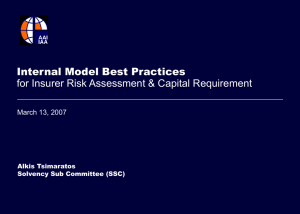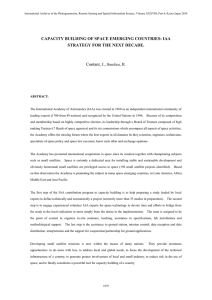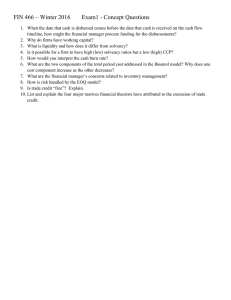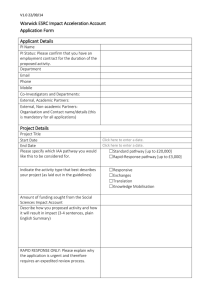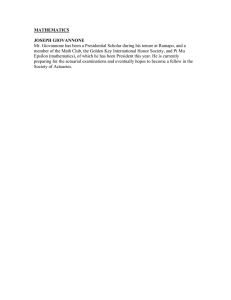Why You Should Care About International Issues Amy S. Bouska Glenn Meyers
advertisement
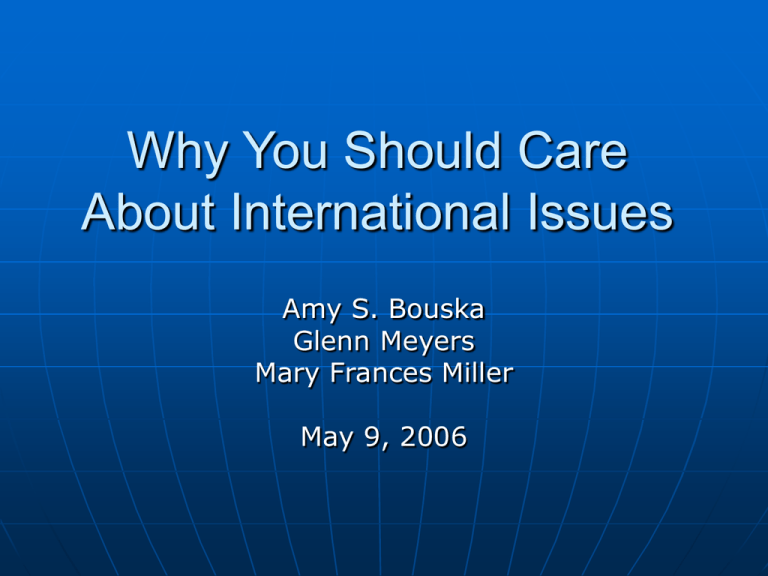
Why You Should Care About International Issues Amy S. Bouska Glenn Meyers Mary Frances Miller May 9, 2006 Why You Should Care About International Issues Working across Boundaries International Practice Guidelines Amy S. Bouska Working Parties and Committees Most of our shared work to date is with the Institute/Faculty of the UK • The Loss Simulation Model Working Party has seven non-CAS members • In addition, three other CAS committees/working parties have members from other organizations • At least five CAS members are working on GIRO working parties In March, we were approached by the Institute of Actuaries of Australia about the development of joint research projects Much of the work on reserve variability is being driven overseas International Actuarial Standards of Practice (IASPs) The IAA has issued eight IASPs: • IASP 1: Guidelines of Actuarial Practice for Social Security Programs • IASP 2: Actuarial Practice • IASP 3: Classification of Contracts • IASP 4: Measurement • IASP 5: Current Estimates • IASP 6: Liability Adequacy Testing • IASP 7: Discretionary Participation Features • IASP 8: Changes in Accounting Policies • Glossary ... And has four drafts out: • • • • Embedded Derivatives and Derivatives Business Combinations Accounting for Reinsurance Contracts Disclosure of Information about Insurance Risk IASPs are promulgated in the context of IFRS IASPs In spite of their name as “standards of practice,” the IASPs issued to date are actually class 4 standards, or “practice guidelines” • These are considered to be “educational in nature, representing a statement of good practice” National organizations that are members of the IAA may adopt the IASPs or develop their own standards that are substantially similar • The US has not taken any action • The CAS has deferred to the Academy Individual members of member organizations will ultimately be bound by the IASPs (or substantially similar documents) The IASPs can be found in the Library section of www.actuaries.org International Issues A Global Framework for Insurer Solvency Assessment and Beyond Glenn Meyers Outline Describe Scope of • IAA Insurer Solvency Assessment Working Party • IAA Solvency Subcommittee – Under IAA Insurance Regulation Committee Other Committees • Working Party on Risk Margins for Liabilities Background • 2002 – The IAA formed the a working party to support the International Association of Insurance Supervisors (IAIS) to assist in the development of Global Standards for Insurer Solvency Assessment (Risk Based Capital) • 2004 – Published report – http://www.actuaries.org/LIBRARY/Papers/Global_Framework_Insurer_Solvency_Assessment-members.pdf – Or follow link on IAA Website (www.actuaries.org) • 2004 – Formed IAA Solvency Subcommittee Summary of WP/SSC Work • See CAS 2004 Spring Meeting Presentation http://www.casact.org/coneduc/spring/2004/handouts/ • Three Pillar Approach – 1. Minimum Capital Requirements – 2. Supervisory Review Process – 3. Measures to Foster Market Discipline • 2004 report focuses on risk-based capital formulas in support of Pillar 1. Risk Based Capital Formulas • Standard Formula – Based on publicly available data – Deliberately conservative • Internal Models – Built to reflect individual insurer situations – Based on “state of the art” actuarial modeling techniques. • Standards and “best practices” for internal models are evolving. What Countries Are Doing • Australia – Already implemented this approach • Swiss Solvency Test – Draft formula under evaluation by Swiss Insurers. – One link under Google search http://www.mathematik.uni-ulm.de/finmath/ws_0506/fe/papers/Luder.pdf • United Kingdom FSA – Requires insurers to build internal models to measure risk-based capital. – To demonstrate belief in models, insurers have to make use of model in company operations. GCIC Solvency II On the way to Solvency II Rolf Stölting Stockholm June 2004 Meyers Comment These slides highlight EEC activities on Risk Based Capital 12 Overview over initiatives / working groups (Europe) Internal Market DG Financial Institutions: Insurance CEIOPS Committee 28 countries: EU, Norway, Iceland, Liechtenstein Bureau of European Insurance and Occupational Pensions Supervisors Pillar I Life Pillar I Life Groupe Consultatif Pillar I Non-life Pillar I Non-life Pillar II Pillar II founded 1978 as technical advisory institution for the EU Association of European actuarial associations Pillar III Account. Pillar III Account. Groups etc. Groups etc. Project team Advisory Board EU Commission Institut des Actuaires DAV Institute of Actuaries Ausschuss Rechnungsl./ Solvab. Consultative Panel appr. 15 named persons: CEA Mutuals, Groupe Consultatif etc. Solva. Solvabilität IAS Leben Nichtleben IFRS Working Group on Solvency II CEA (Comité Européen des Assurances) GDV March 2004 GCIC Solvency II FFSA Solv. II Solvency II Solv. II Life Non-life Assets ABI 13 Overview over initiatives / working groups (international) DAV CAS Institute of Actuaries International Association of Actuaries (IAA) AFIR ASTIN IASB G-7 IAIS Subcomm. Solvency Subcomm. Reinsurance GCIC Solvency II IMF OECD BIS (Basel II) ….. Subcomm. …. Insurance Regulation Committee Reinsuran. Solvency Subcomm. Subcomm. 14 March 2004 MARKT/2543/03 – Issues regarding technical provisions GCIC Solvency II How to get an explicit level of prudence, e.g. by using best estimate + explicit risk margin What level of prudence should be set? How to define a technical interest rate? How to define books of contracts (or lines of business)? How should equalization provisions be treated, especially considering the classification of IFRS? 15 MARKT/2543/03 – Issues regarding target capital GCIC Solvency II Spectrum of approaches – European formula, standard formula, internal models Which is the most suitable risk measure, Value at Risk or Tail Value at Risk? Which time horizon to choose? What is a suitable level of confidence? Should the Standard model be based on probability distributions or scenarios? How to take dependencies and correlations between different lines of business into account? 16 MARKT/2502/04 – Asset management & ALM GCIC Solvency II Investment risk as part of the target capital requirement Prudent person approach for the future prudential system (including ALM) Requirement for an investment plan Incorporation of ALM-risk both in standard formula and in internal models ALM relevant for life as well as for non-life business 17 Activity in USA • NAIC Casualty Actuarial Task Force – Include cat model in RBC • Rating Agencies – Moody’s - Has risk-based capital formula – Fitch - RBC formula under development – Standard and Poors - Wants insurers to develop internal models. Standard and Poors • David Ingram article in Risk Management Section newsletter http://library.soa.org/library-pdf/RMN0603.pdf • Quote from article "Insurers that use regulatory or rating agency risk-based capital formulas without modification will be pressed to demonstrate that those models appropriately capture the actual risk of their specific business. Insurers that modify those formulas in an appropriate manner to reasonably approximate the capital needed to support their risk positions are seen to have adequate practice in this area." Other Activity to Watch Risk Margins Working Party • Acting on request from IAIS • Reported liabilities “should” include a risk margin. • Two general approaches being considered. – Standard Actuarial • e.g. Australian requirement to post reserves at 75% level – Cost of capital approach • Fair Value accounting “mark to model” approach • Diversification and insurer size effects reflected in capital requirements • This is where I think they are going. Stay tuned. International Actuarial Education Standards & Process Why Should I Care? Mary Frances Miller International Actuarial Association IAA is an organization of organizations Umbrella group aims to include all credentialed actuaries worldwide 55 full member associations + associate members • CAS, SoA, AAA, CIA, CCA are all full members Aims • Speak for the profession globally • Gain recognition for the actuary as a profession • Promote professionalism & standards Full Members of the IAA Constitution & By-Laws that meet certain criteria, e.g. • Discipline process • Method for setting standards (if the association does so) “Fully Qualified Members” meet or exceed minimum education criteria All allow the IAA to “sell” actuaries who belong to member Assns as recognized professionals The IAA Syllabus Ten Topics • • • • • • • • • • Financial Math Prob & Stats Economics Accounting Modelling Statistical Methods Actuarial Math Investments & Assets Actuarial Management Professionalism No requirements for delivery method • Independent exams • University based All topics at least on a 2 out of 3 scale • Some should get more emphasis than others • Can be delivered in any combination / order Minimum standard Why do we care? CAS education far exceeds the IAA syllabus • IAA standards a potential issue only for life contingencies and assets CAS members are recognized worldwide • Or are they? • Statutory roles often require local membership IAA lobbies International Assn of Ins Supervisors to set the standard as full member organizations & their members IAA working cooperatively with International Accounting Standards Board Growing Urgent Need for Actuaries Emerging economies seeing a surge in spending power & the need for insurance • Central & Eastern Europe • Latin America • Central Asia Primarily property & auto Explosion of local & regional companies Little or no actuarial expertise or association World Bank Supports strong economic systems, especially in financial services Growing recognition that insurance is critical to a healthy economy Growing concern that insurance failures are over the horizon • Unsophisticated regulatory systems • Little/no actuarial role • Corruption – cash flow temptation Critical need to grow the profession in underserved areas CAS Support Exam sites in 21 countries Heavily subsidized exam fees Library materials provided to associations Most syllabus material available on the web Professionalism course offered in Asia Issues Even the subsidized exam price is steep CAS membership doesn’t automatically lead to local qualification Perceived colonialism Natural conflict for resources with North American candidate and member needs Competition(?) with other international associations: I&FoA, IAAust, SoA Depends on the generosity of our members Proposed IAA Education Programme Series of modules to meet at least the IAA syllabus Multiple languages Multiple delivery options Consistent quality Available to any association that chooses to use part or all Available in areas with no association (yet) To be viewed as yet another program in a world that currently has 50+ programs Advantages Most associations are quite small Need about 1000 members for an effective exam-based system • Fewer if universities are used, but still resource intensive International program avoids duplication of effort Allows smaller associations to concentrate on other issues • • • • Qualification standards Standards of practice Nation- or practice-specific education Continuing education Who is expected to use it? Brand new associations Candidates in areas without an association Smaller societies without a wellestablished program (e.g. Eastern Europe) Institute & Faculty of Actuaries (!) Design Plans Tap into best of existing systems and materials Likely to use Australian university/association system as a model Exam option Recognizes that IAA syllabus is not at “fellowship” level • Specializations • Local accounting & regulatory needs Funding Associating the program with the international association rather than a particular society opens up funding from outside the profession Pilot program funding to be coordinated by World Bank • Expect multiple donors, e.g. USAID, IADB in the US • Will seek corporate sponsors as well • Volunteer support, but to a lesser extent Associations (x emerging economies) that adopt will charge fees to cover their candidates’ costs Continuing outside donor support for emerging economies Rollout Identified pilot countries • • • • Growing insurance market Potential for effective regulatory cooperation Funding (e.g. IADB Latin America) Local support University, actuarial association or both 2-4 pilots to be tested • 5 year plan • Significant, measurable outcomes • No expectation that process will be complete in 5 years CAS Participation Mary Frances Miller & Cynthia Ziegler on IAA Task Force • Significant staff support for budget & business plan (note that CAS is recognized as master at budgetary efficiency) CAS objectives in the design phase • Keep IAA program modular • Try to steer construction to feed into CAS advanced education (5 or 6 exam level?) • Try to steer construction to provide p/c focused modules earlier rather than later in the process Meets World Bank objective to get people trained faster • Insist on dual path – allows for working people to become qualified as well as university-age candidates
